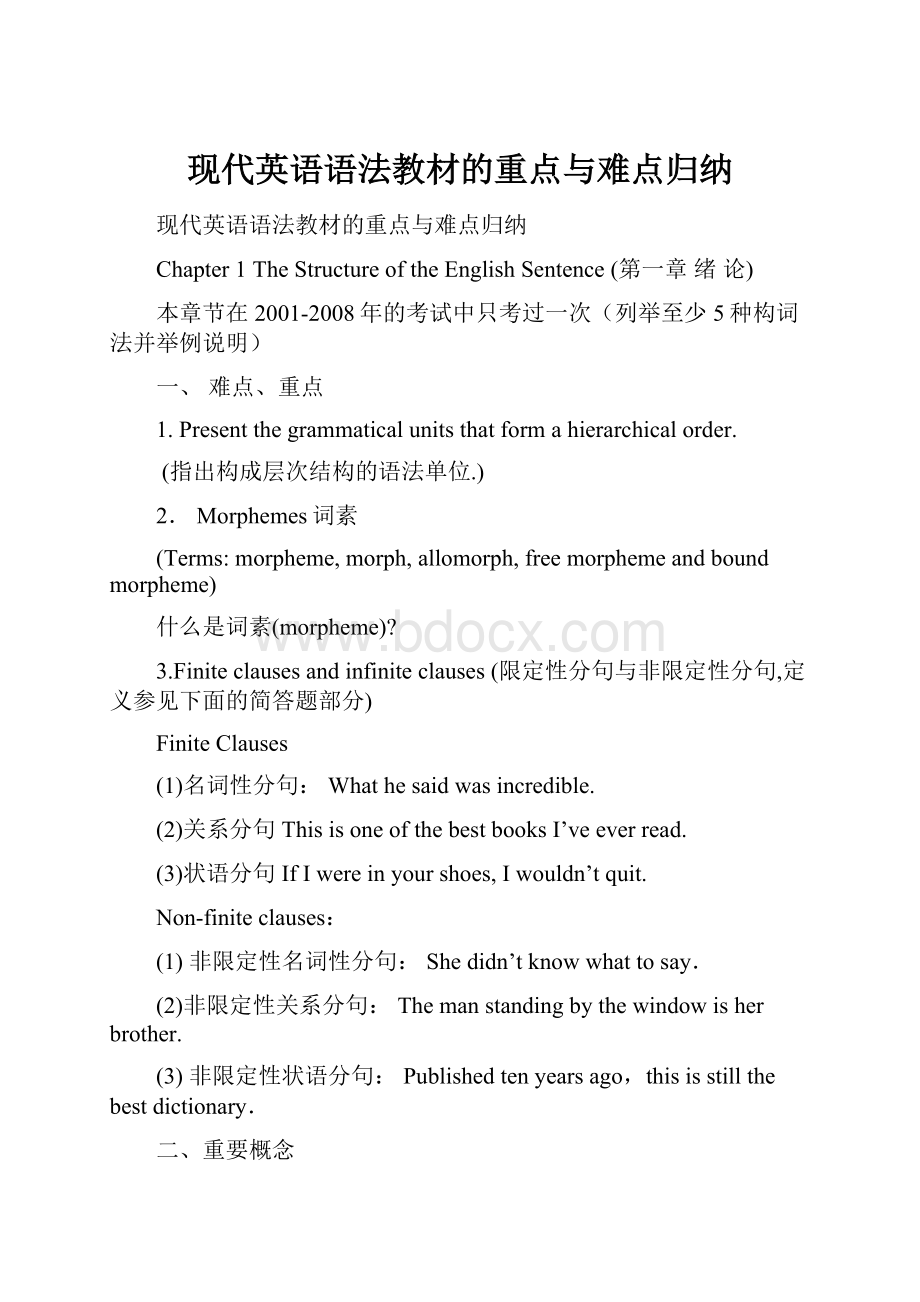现代英语语法教材的重点与难点归纳.docx
《现代英语语法教材的重点与难点归纳.docx》由会员分享,可在线阅读,更多相关《现代英语语法教材的重点与难点归纳.docx(28页珍藏版)》请在冰豆网上搜索。

现代英语语法教材的重点与难点归纳
现代英语语法教材的重点与难点归纳
Chapter1TheStructureoftheEnglishSentence(第一章绪论)
本章节在2001-2008年的考试中只考过一次(列举至少5种构词法并举例说明)
一、难点、重点
1.Presentthegrammaticalunitsthatformahierarchicalorder.
(指出构成层次结构的语法单位.)
2.Morphemes词素
(Terms:
morpheme,morph,allomorph,freemorphemeandboundmorpheme)
什么是词素(morpheme)?
3.Finiteclausesandinfiniteclauses(限定性分句与非限定性分句,定义参见下面的简答题部分)
FiniteClauses
(1)名词性分句:
Whathesaidwasincredible.
(2)关系分句ThisisoneofthebestbooksI’veeverread.
(3)状语分句IfIwereinyourshoes,Iwouldn’tquit.
Non-finiteclauses:
(1)非限定性名词性分句:
Shedidn’tknowwhattosay.
(2)非限定性关系分句:
Themanstandingbythewindowisherbrother.
(3)非限定性状语分句:
Publishedtenyearsago,thisisstillthebestdictionary.
二、重要概念
1.morpheme
2.Definethecomplexsentence
Thecomplexsentenceisasentencethatcontainsmorethanoneclausethatarejoinedtogetherbysubordinatingonetoanother.[复杂句是用从属连词(如if,when,though等)连接的一个以上分句的句子.]
三、典型考题
I.选择题
1.Thereare()morphemesin“gunfighter”.
A.twoB.threeC.fourD.one
2.In“Hedownedhisbeerandpunchedmeonthenose.”“downed”belongsto().(P13)
A.backformationB.clippingC.conversionD.blending
3.Suffixesbasicallychange().
A.wordmeaningB.wordclassC.nothingD.wordformation
4.Theprefix“uni-”means().
A.withoutB.selfC.falseD.one
Key:
1.B2.C3.B4.D
II.简答题
1.Intermsofwhichthreefactorsarewordsclassified?
Thethreefactorsare:
theenvironmentwherewordsoccur,theirinternalstructureandtheirmeaning.
2.Definethefiniteclausesandthenon-finiteclauses.
Thefiniteclausesaretheonesthathavesubjectsandfiniteverbsaspredicates.Thenon-finiteclausesaretheonesthatleavesubjectsunsaidandverbsinnon-finiteforms.(限定分句是主语加限定动词作谓语的分句。
非限定分句是省略主语而动词以非限定形式出现(主语省略是因为其前面或
后面已有主语。
)
Chapter2SentenceTypes(第二章句子类型)
一、难点、重点
1.ThefourmajortypesofsentencesinEnglishandtheirdiscoursefunctions.
2.Explaintheconditionsinwhichweneedtousenon-assertivewordsinpositivestatementsandassertivewordsinquestions.(解释在肯定句中使用非肯定词和在疑问句中使用肯定句的情况。
)
另外,在附加疑问句中,HAVE一词也是常考的重点:
Youhaveheardme,haven’tyou?
(Auxiliary‘have’)
Maryhastoliveonherown,doesn’tshe?
Tomhascoffeewithmilk,doesn’the?
(Inthesenseof‘possess’,‘own’,etc.)Youhaveabighouse,don’t/haven’tyou?
4.Commands
二、重要概念
1.Alternativequestions:
Thosequestionsthatsuggesttwo(ormore)alternativesandusuallyimplythatoneofthemcouldbetrue.
2.How-exclamations:
Exclamationsthatareledbytheadverb‘how’.Ithighlightstheadjective,adverb,orverbinexclamations.
三、典型考题
I.选择题
1.Youhavetowaitamoment,______?
A.haven'tyouB.doyouC.don'tyouD.shouldn'tyou
2."Marywasn'tinthereading-room,wasshe?
""_________."
A.Yes,shewasn'tB.No,shewasC.Yes,shewasD.Shewasn't
Key:
1.c2.c
II.简答题
1.Whataretheverbswhichtransferrednegationoftenoccurswith?
Whatistheirsharedsemanticfeature?
(转移否定经常与哪些动词同现?
它们有什么共同的语义特征?
)
Theverbswhichtransferrednegationoftenoccurswithare:
think,believe,suppose,imagineandexpect.Theyaretheverbsthatexpress“opinion”.(转移否定经常与think,believe,suppose,imagine和expect等动词连用。
这些动词都是表示“意见”的语义。
)
2.Whatarethetwomajortypesofexclamations?
(感叹句的两大类型是什么?
)
ThetwomajortypesofexclamationsareWHAT—exclamationsandHOW-exclamations.Theformerisfollowedbyanounphrase;thelatterisfollowedbyanadjectiveoradverb.感叹句分为WHAT-感叹句和HOW-感叹句。
前一种后接名词词组,后者接形容词或副词。
III.完成下列句子
1.You’dratherwedidn’tgothere,_______
2.Idon’tthinkhewillcome,________?
3.Theymusthavelosttheirway,_____?
4.Let’stalkaboutitlater,_____?
5.Everyoneishere,________?
Key:
1.hadn’tyou2.willhe3.mustn’t/didn’tthey4.shallwe5.isn’there/aren’tthey
Chapter3NounandNounPhrase
(1):
NounandNumber
(第三章名词和名词词组
(1):
名词和名词的数)
一、难点、重点
1.Thefunctionsofnounphrases:
Infunction,anounphrasecanplaysuchgrammaticalrolesassubject,object,complement,modifierandevenadverbial.名词词组的功能,可以作主语、宾语、补语、修饰语(ateatable),有些的甚至可以作状语(yesterday,lastweek)。
2.Nounclasses
名词可以以多种方法分类,如具体名词(table,water)与抽象名词(happiness,hatred),可数名词(table,girl)与不可数名词(water,money),有生物名词(boy,monkey)与无生物名词(table,water)等.但名词通常按以下方式分类:
我们在可数名词和物质名词中还可以再划分具体名词和抽象名词:
名词--|专有名词
|普通名词--|可数名词--|具体名词(concretenouns)
(commonn.)||抽象名词(abstractnouns
|物质名词--|具体名词(concretenouns)
|抽象名词(abstractnouns)
3.熟记教材(P65)单位名称表
二、重要概念
1.Propernoun(专有名称是特指人,地方或事物的名词)
2.Massnoun:
(没有复数形式的名词叫物质名词)
3.Unitnoun:
(单位名词亦称“部分词”用于说明所修饰名词的量、大小和形状等)
4.Foreignplurals:
(外来词复数是指从外语中借来尚保持原来复数形式的复数名词,多是拉丁语、法语和希腊语等)
三、典型考题
I.选择题
1._________plasticsaremadeinthischemicalplant.
A.ManykindofB.ManykindsofC.ManykindsD.Manykind
2."Jackhasjustmovedintoanewhouse."
"Didhehavetobuy________forit?
"
A.manynewfurnitureB.muchnewfurnitures
C.muchnewfurnitureD.manynewfurnitures
3.Michaeltook_______astowhatheshoulddo.
A.hisfriend'sadviseB.hisfriend'sadvises
C.hisfriendadviceD.hisfriend'sadvice
Key:
1.B2.C3.D
II.简答题
1.Collectivenoun:
(集体名词一般是可数名词,但就是单数,也指人,动物或事物的群体)
2.singularinvariables:
(单数名词指的是某些国家名称,人名和表示学科、疾病和运动项目等形式上有以—s结尾的名词,一般用作单数)
3.pluralinvariables(复数名词指由两部分构成的工具或服饰;某些集体名词;山脉、瀑布、群岛等地理名词以及其他以-s结尾的名词,用作复数)
III.其他题型
Supplytheappropriateunitnounfromthelistbelow:
companycollectiontroopherdbundledroppiece
rayswarmcanschoolpackfleetcrew
1.a______ofships2.a______oflies3.a______offirewood
4.a______ofwhales5.a______ofsailors6.a_____ofbees
7.a______oftourists8.a_____ofcrudeoil9.a______ofcattle
10.a_____ofmusic11.a_____ofmonkeys12.a_____ofcoins
13.a_____ofblood14.a_____ofsunshine
Key:
1.fleet2.pack3.bundle4.school5.crew6.swarm7.company8.can
9.herd10.piece11.troop12.collection13.drop14.ray
Chapter4NounandNounPhrase
(2):
DeterminerandGenitive
(第四章名词和名词词组
(2):
限定词和属格)
一、难点、重点
1.Theconstraintsthatthedoublegenitiveissubjectto:
Thesecondnouninthedoublegenitivealmostalwaysreferstopersons,nevertoobjects,andthefirstnounusuallyhasindefinitereference(typicallypremodifiedbytheindefinitearticle)andthesecondnounisalwaysdefinite.(双重属格的第二个名词指人,不指物,第一个名词不确指,通常用不定冠词,第二个名词必须确指)
2.Groupgenitive集体属格
集体属格是指把’s加在后位修饰词组或并列名词词组后面的属格,如:
someoneelse’scar,anhourandahalf’stest(一个半小时的测试),aweekorso’sbreak(一个星期左右的休息)。
但集体属格不用于含有后位修饰分句(限定分句和非限定分句)的名词词组中:
*theladylivingnextdoor’shat
*thechildrenkilledinthewar’spictures
3.Genitive:
Generally,of-phraseisnotusedwithfirstnames,butwouldbeacceptablewithfullnames:
*ThebikeofTom
ThecarofGeorgeBush
4.Determiners
Thepre-determinersorcentraldeterminersaremutuallyexclusive:
*allhalftheemployees(twopre-determiners)
*allthehisemployees(twocentraldeterminers)
5.Thedifferencebetween‘all’and‘whole’whentheymodifyapropername:
AllBeijingwasexcitedatthenewsofwinningthebid.
ThewholeofBeijingwasexcitedatthenews.
*WholeBeijingwasexcitedatthenews.
*ThewholeBeijingwasexcitedatthenews.
*TheallBeijingwasexcitedatthenews.
二、重要概念
1.Determiners(什么是限定词)?
(限定词是指用于各词词组的前位修饰语的词,限定词放在修饰中心词的形容词前面)
2.Genitives:
Formsorconstructionusedtodenotepossession,measurementorsource.Example:
John’scar;amoment’sdigression;theresistanceofIraq
三、典型考题
I.选择题
1.Jackis____________________.
a.afriendofadoctor’sb.thefriendofadoctor’s
c.thefriendofthedoctor’sd.afriendofthedoctor’s
2.Thisis________________________.
a.thepassportofJohnb.thepassportofJohn’s
c.thepassportofJohnSmithd.theJohnpassport
Key:
1.d3.c
II.简答题
1.Whataregenericreferenceandspecificreference(什么是类指和特指)?
Genericreferenceandspecificreferencearethetwousesofarticles.Geneticreferenceindicatesthewholespeciesorkind,whilespecificreference,specificoneorthing.[类指和特指是冠词的两个用法。
类指指事物(或人)的整个种类,而物特指则是某一具体的事物(或人)]
2.Underwhatgeneralcircumstancesdoweprefergenitivetoof-phraseandviceversa?
(在什么情况下用属格不用of-词组,什么情况下用of-词组,不用属格?
)
Whennounsrefertopeople,andtherelationbetweenthenounsisoneofdefinition,classification,etc,genitivesarepreferred,whennounsrefertoinanimate,lifelessobjects,andtheheadwordsofnounphrasesareclassifyingadjectives,of—phrasesarepreferred.(当名词指人,或名词之间属于定义或归类关系时,用属格;而当名词指无生物,或中心词是the+形容词时,用of-词组)
examples:
men’sclothes/theteacher’sbook
thecolorofthecar/thestruggleoftheexploited
Chapter5VerbandVerbPhrase
(1):
Tense,AspectandFuture
(第五章动词和动词词组
(1):
时、体和将来时间)
一、难点、重点
1.Whydoesthisbookadoptthesystemoftwotensesandtwoaspects?
本书采用两时两体体系,理由有三。
第一,传统语法是以时间为参照划分英语时态的,而在处理像Thetrainleavesateighttomorrowmorning和Theywouldhaveheardthenewslastnight等句子时遇到麻烦,因为在语言中形式与意义是不常等同或对应的。
我们将英语的时分为两时——现在时和过去时,是基于对英语形态的考虑。
像汉语这样没有词汇屈折变化的语言根本就没有时。
第二,时(tense,)和体(aspect)是两个彼此独立的语法范畴。
前者基于词汇的屈折变化,而后者基于结构分析。
由于时与体经常合用,所以导致时体不分,时指动作发生的时间而体标记动作发生的状态或方式。
第三,从教学角度上看,新的时体体系简单易学,还可以让学生懂得一种意义可以用不同的形式表示,一种形式也可表示不同的意义。
2.Whyisthepasttenseoftenusedforpoliteness?
(过去时为什么常用来表示客气的语气?
)
Becausethepasttensecanmakeaquestionorastatementorasuggestionlessdirect.Itismorepolitetousethepasttenseonthepartofthespeaker.(因为过去时使疑问句、陈述句或建议不直接提出,显得委婉,所以说话者觉得它比现在时更利于表达客气的语气。
)
3.Since-分句一般不用于否定句:
Wehaven’tseeneachothersince1989.
*It’stenyearssinceIdidn’tseehim.
*He’shadseveraljobssincehewasn’tastudent.
二、重要概念
1.Tense:
Anyoneoftheinflectedformsintheconjugationofaverbthatindicatesthetemporallocationofaneventorastateofaffairs.时态指示时间如过去、现在动词的各种曲折变化形式的任何一种
2.Aspect:
aspectreflectsthewayinwhich